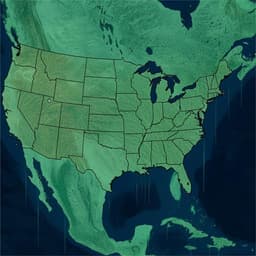
Earth Sciences
Acceleration of U.S. Southeast and Gulf coast sea-level rise amplified by internal climate variability
S. Dangendorf, N. Hendricks, et al.
This groundbreaking research reveals a rapid sea-level rise along the U.S. Southeast and Gulf coasts since 2010, the fastest observed in over a century. Conducted by authors including Sönke Dangendorf and Noah Hendricks, this study explores the interplay between ocean dynamics and climate variability, highlighting an urgent environmental concern.
~3 min • Beginner • English
Introduction
Global mean sea level (MSL) has risen by about 1.5 mm/yr since 1900 and has been accelerating since the 1960s, exceeding 3 mm/yr in the satellite era. Along the North American East and Gulf coasts, MSL changes reflect a combination of vertical land motion (natural and anthropogenic), sterodynamic sea level (global steric changes plus ocean circulation), and Gravitation, Rotation and Deformation (GRD) effects associated with mass redistribution. Regional MSL trends between 1900 and 2021 range from 1.7 to 8.4 mm/yr, with substantial societal impacts including increases in nuisance flooding and heightened storm damages. Recent NOAA/NASA near-term projections generally align with intermediate scenarios for much of the U.S. coast, but quadratic extrapolations (trajectories) indicate that the eastern Gulf coast is tracking or exceeding a high-end scenario, suggesting a strong recent acceleration. The key research question is whether the observed large recent acceleration represents a robust externally forced signal implying high-end future trajectories, reflects unresolved processes such as nonlinear VLM, or is primarily due to internal ocean dynamic variability that is out of phase with climate model simulations. The study aims to detect and attribute accelerations in regional MSL, place recent rates in a 20th-century context, and assess consistency with forced responses from climate models versus internal variability.
Literature Review
Prior work has established global MSL rise and its acceleration driven by thermal expansion and land ice mass loss, with regional variability along the U.S. East and Gulf coasts influenced by VLM, SDSL, and GRD fingerprints. Earlier studies documented spatially varying trends, hotspot accelerations in parts of the Mid-Atlantic Bight and Chesapeake Bay, and links to Gulf Stream dynamics, wind forcing, and river discharge. NOAA/NASA reports compared process-based projections with observational trajectories, highlighting discrepancies in the eastern Gulf where observations approach high-end scenarios. Other studies emphasized detection challenges due to long-memory noise, coherence and phase relationships between coastal sea level and basin-scale dynamics, and the role of tropical Atlantic wind stress curl and Rossby waves in modulating coastal sea level.
Methodology
Data and preprocessing: 66 monthly tide-gauge records (PSMSL) along the North American East and Gulf coasts for 1900–2021 were used. Records were gap-filled via an adjusted DINEOF approach initialized with a local Kalman Smoother and hybrid reconstructions, achieving an RMSE of 2.7 cm using 10 iterations; analyses preferentially used observed data points for rate estimates. Vertical land motion (VLM) corrections: Linear VLM from ref. 7 (GNSS or tide gauge minus nearby altimetry with nonlinear crustal adjustments) available at 55 sites; elsewhere, weighted-ensemble GIA model estimates were used. Nonlinear VLM for subsiding Louisiana/Texas sites was inferred by differencing to a stable reference (Pensacola; alternative Cedar Key) after accounting for barystatic GRD fingerprints, GIA, and inverted barometer; SSA with 30-year cutoff captured nonlinear VLM. Trend and acceleration detection: Singular Spectrum Analysis (SSA) extracted nonlinear trends at periods >30 years; Monte Carlo noise experiments generated 1000 artificial long-memory series per site with Hurst coefficient ≈0.8 (site-specific variance) plus observed linear trend to test whether observed rates exceeded the 95th percentile of natural variability, indicating significant acceleration. Component separation: Tide-gauge records were corrected for GRD effects (barystatic fingerprints from a 100-member ensemble, linearly extrapolated to 2021) and for the inverted barometer effect (1 hPa ≈ 1 cm). Coastal wind effects were estimated using a global barotropic model to 2012 and extended to 2021 via multiple linear regression with NCEP R-2 wind stress in a 4° box around each gauge. River discharge contributions used aggregated time series for four regions (1910–2018); linear regressions estimated local sensitivities (0.1–1.4 mm per km3/yr). SDSL estimation: After removing GRD and inverted barometer, residuals represent coastal SDSL; coherence among stations south of Cape Hatteras was quantified. Satellite altimetry comparisons: Quadratic coefficients (accelerations) were fit to altimetry and tide gauges over 1993–present to examine spatial patterns and rule out residual VLM as the acceleration source; steric height (upper 2000 m) fields assessed thermosteric contributions (Subtropical Gyre expansion). Climate model comparisons: SDSL from CMIP5/CMIP6 was computed combining zos and zostoga, de-drifted using pre-industrial control quadratic fits; historical forcings to 2005 then RCP8.5/SSP5-8.5 thereafter. CESM Large Ensemble (38 members) provided a single-model forced response benchmark (zos plus observed global mean steric). Unforced residuals were obtained by subtracting ensemble medians; phase-scrambling (100 realizations per run) generated large ensembles preserving spectra to assess bounds of internal variability. Rossby wave modeling: A 1.5-layer reduced gravity model (forced solely by wind stress; parameters g′=3 cm/s2, decay 1/R=1.5 years, latitude-varying first-mode baroclinic Rossby wave speeds 17 cm/s at 14°N to 2.5 cm/s at 50°N) was driven by 20th Century Reanalysis v3 winds (1900–2015) to simulate westward-propagating signals from the eastern Atlantic to the Americas. Validation via pointwise correlations with altimetric sea surface height showed substantial explained variance in the open ocean. Principal component analysis of model outputs west of 50°W isolated leading modes (~78% variance) used as predictors in stepwise regression against the coastal SDSL index south of Cape Hatteras. Lead–lag correlations between Caribbean (e.g., Magueyes Island, PR) and U.S. Southeast/Gulf tide gauges assessed advection timescales. Statistical analysis: Detrended Fluctuation Analysis estimated Hurst coefficients (median 0.8 ± 0.05) for generating long-memory noise; significance threshold P ≥ 0.95 for acceleration detection.
Key Findings
- Tide gauges along the U.S. Southeast and Gulf coasts show a marked acceleration since the early 2000s, with rates exceeding 10 mm/yr since 2010 and reaching 11.1 mm/yr at Pensacola by end of 2021; these are unprecedented in at least 120 years south of Cape Hatteras and statistically significant (P ≥ 0.95).
- The acceleration is regionally coherent south of Cape Hatteras and much larger (2–3×) than rates north of Cape Hatteras, which largely lack significant accelerations in the same period.
- Satellite altimetry and tide-gauge quadratic fits (1993–present) show consistent acceleration patterns extending from the western Gulf of Mexico along the U.S. East Coast up to Cape Hatteras and offshore into the Caribbean and Subtropical Gyre, with maxima >1 mm/yr^2, indicating an ocean-dynamic (sterodynamic) origin rather than residual VLM.
- Steric height (upper 2000 m) analysis shows that Subtropical Gyre expansion primarily drives the acceleration; the central Gulf of Mexico shows a deceleration, consistent with gyre-scale dynamics.
- After removing GRD and inverted barometer effects, coastal SDSL residuals are highly coherent across stations. Observed SDSL accelerations exceed the CMIP5/CMIP6 ensemble median forced response over the past decade.
- Decomposing observations: approximately 40% of the recent acceleration aligns with externally forced trends from climate models, while ~60% is attributable to internal variability that is out of phase with model ensembles.
- Unforced residual SDSL variability correlates strongly with internal climate variability estimates constructed from wind-forced Rossby waves, coastal winds, and river discharge (correlation r ≈ 0.80–0.81); multi-year internal variability exhibits peak-to-peak amplitudes of roughly −45 mm (about −25 mm from open-ocean wind stress, plus contributions from alongshore winds and river discharge).
- Lead–lag analyses indicate Caribbean sea level leads U.S. Southeast/Gulf coastal sea level by ~6–8 months (r ~ 0.8), consistent with advective transfer of density anomalies through the Gulf Stream system and into coastal regions.
- The findings suggest recent high observed rates likely reflect a temporary superposition of forced acceleration and internal variability rather than a sustained trajectory toward high-end sea-level rise scenarios.
Discussion
The study addresses whether the recent rapid rise along the U.S. Southeast and Gulf coasts represents a high-end forced trajectory or is amplified by internal variability. By correcting for GRD and atmospheric pressure effects and comparing coastal SDSL to climate model forced responses, the authors show that the observed acceleration exceeds the median forced signal from CMIP5/6 and CESM-LE, but when the forced component is removed, residuals fall within the bounds of internal variability. Spatial agreement between altimetry and tide gauges and the offshore structure implicate sterodynamic processes linked to Subtropical Gyre dynamics rather than unresolved VLM. Strong coherence and lead–lag relationships with the Caribbean, and high correlations with wind-forced Rossby wave indices, indicate that tropical North Atlantic wind stress curl drives westward-propagating signals that subsequently affect the Gulf Stream pathway, the Caribbean inflow, and coastal sea level south of Cape Hatteras. Consequently, the accelerated rates observed since the 2010s likely result from constructive interference between external forcing and internal decadal variability. This interpretation implies that regional rates may recede toward model-projected averages within the next decade as internal variability shifts phase. The results underscore the challenges of early detection of accelerations for planning and the need to account for internal variability when comparing local observations to projections.
Conclusion
The paper demonstrates a statistically significant, unprecedented acceleration of mean sea level since the early 2000s along the U.S. Southeast and Gulf coasts, with rates surpassing 10 mm/yr after 2010. The acceleration is predominantly sterodynamic, associated with Subtropical Gyre expansion, and extends into the Caribbean and North Atlantic. It exceeds the median forced response of climate models, but after removing the forced component, the residuals are consistent with internal variability driven largely by tropical North Atlantic wind-forced Rossby waves, with additional contributions from alongshore winds and river discharge. Approximately 40% of the recent acceleration is externally forced and ~60% is internal variability. These findings suggest that the current high rates are unlikely to indicate a persistent high-end trajectory, and regional rates may revert toward model projections as internal variability evolves. Future research should focus on dedicated ocean model sensitivity experiments to better elucidate the pathways and time lags by which Rossby wave signals and gyre-scale dynamics modulate coastal sea level, improve mechanistic understanding at regional scales, refine VLM and other local contributions, and develop improved early detection methods that explicitly account for long-memory noise and internal variability.
Limitations
Potential uncertainties stem from residual or unmodeled nonlinear VLM outside the Gulf of Mexico, though altimetry–tide gauge consistency argues against VLM driving the recent acceleration. The barotropic wind model only extends to 2012 and is continued by regression to 2021, introducing model-dependence. River discharge data end in 2018, and regressions assume linear, stationary sensitivities. The reduced gravity Rossby wave model simplifies ocean dynamics and excludes buoyancy forcing; mechanisms of signal transfer into coastal zones and precise time lags require further targeted sensitivity experiments. Phase relationships between observations and model ensembles indicate that limited ensemble sizes and differing internal variability phasing in CMIP may affect comparisons. Gap-filling and smoothing choices (SSA, moving averages) may influence rate estimates, though robustness checks were undertaken.
Related Publications
Explore these studies to deepen your understanding of the subject.







